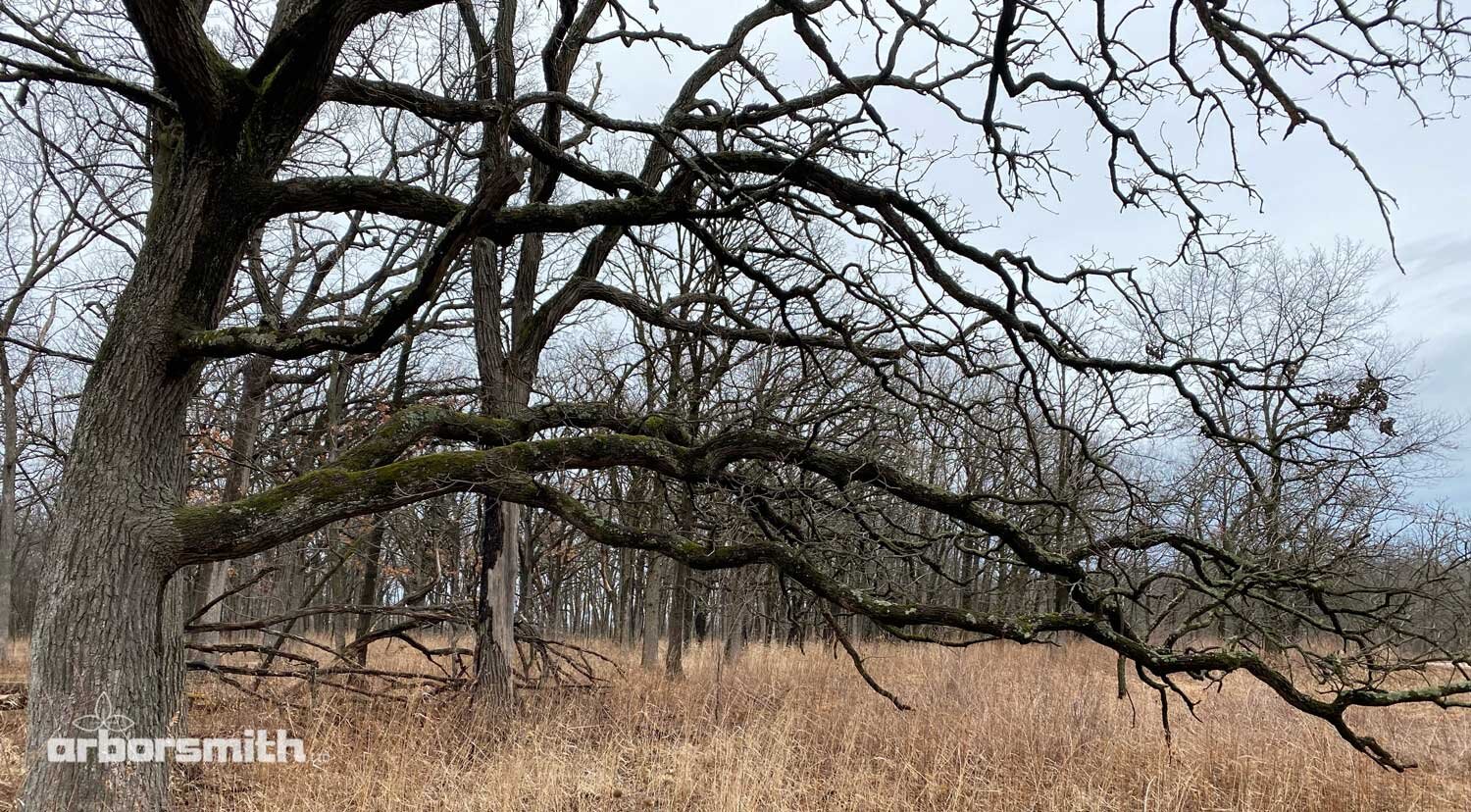How Strong Is This Low Branch’’?
/Backyard Wisdom - May 2021
by: Gilbert A Smith, ISA Board Certified Master Arborist
This White Oak branch has been hanging in there for about 80 years so we can assume that it is pretty strong. Growing in Old School Forest Preserve in Lake County, IL, this tree is in its natural state, but what if it was growing in your landscape? Would you worry about this branch falling? Many homeowners worry, and for what seems like good reason; this branch is low, long and heavy. We wonder, how can it possibly not break? Because of that, in many landscapes, all of the beautiful low branches on our trees are cut off.
Photos by Lesley Bruce Smith
This removal of low branches is done out of ignorance and because the branch is within reach, many people have it cut off so they don't have to worry. Also, when a power saw gets into the hands of a novice or a landscaper who is not supervised by a certified arborist, they think they're doing some good. Quite the opposite, this chopping is doing more harm than good by:
This low horizontal branch on a Live Oak in North Carolina is over 30’ long and probably over 100 years old, and was smooth from all the people who have sat and played on it over the years.
taking away a major source of the trees nourishment (from the sun)
significantly weakening the structure
elimination of stunningly beautiful branch architecture that can never be replaced.
The question remains, how does this branch support itself when even steel beams cantilevered over such a long distance could not hold themselves up? Trees are amazing aren’t they?
First, tree cell walls are composed of carbon chains, as in carbon steel. Their cell structure is tubular, which we know from physics, is a very strong structure.
Second, these strong tubular cells in the trunk and branches grow and knit themselves into concentric tubular layers one on top of the next, every season. That is why you can count the rings on a tree to determine its age. This concentric, circular structure is the reason, that for its weight, wood is still the strongest building material on the planet.
Third, in strong branch attachments, the grain of the cells in the branch interlock every season with the grain of the trunk in a hooked manner much like a latch on a door so they will not pull apart. Picture two “J” structures hooked together by their loops and you can begin to understand this ingenious connection between branch and trunk. Remember though, that those tubular cells are pipes or straws whose main purpose is to transmit water and nutrients. When they bend into those “J” structures this bend restricts the flow in the “pipe”. Trees have been around for longer than the dinosaurs, and believe me they do not waste their energy doing anything that is not critical. They give up efficient water transmission into bent pipes in order to hook each cell together into a bond that is stronger than steel. Amazing! See if you can see the “ Crazy J” pattern where this branch and trunk intersect.
Now, there is one more reason that those horizontal branches won’t break. Tree branches are like your own bones! When they are exercised they reinforce themselves in the areas under pressure. Trees add lignin, the equivalent of calcium in your bones to the bottoms of the long branches to reinforce them even more. Like a baseball pitchers arm is thicker than yours or my arm bones, so our low tree branches are thicker and stronger than branches that don't have to support that weight.
Interestingly if you stick a support post under the branch the tree will stop reinforcing it and the branch will become weaker and always dependent on the crutch. Or when Lesley or I trim an indoor tree that has not been exercised by the wind their branches are weak and floppy. We always tell our clients to shake the tree branches when they pass or set a strong fan on the weak tree.
One of the few times we prescribe structural support cables is when the tree has a weak branch union where the grain is not interlocking but parallel. This kind of union is more common on fast growing trees, for example, Silver Maple, Cottonwood, Honeylocust, Linden and Callery Pear. The least expensive and least invasive treatment for this condition is to trim the trees to develop strong structure, regularly when they are young. The only other option when they are older is to install steel cables high in the crown attached loosely so that the tree can move with the wind.
Those healthy, low branches are really strong, really help the tree remain strong and mostly add beauty and grace. If you ever feel uncomfortable underneath the canopy of your lovely trees please feel free to call us to evaluate them. We love doing it.
Mother Nature’s Moment - What Does It Mean That Trees Are Tribal?







